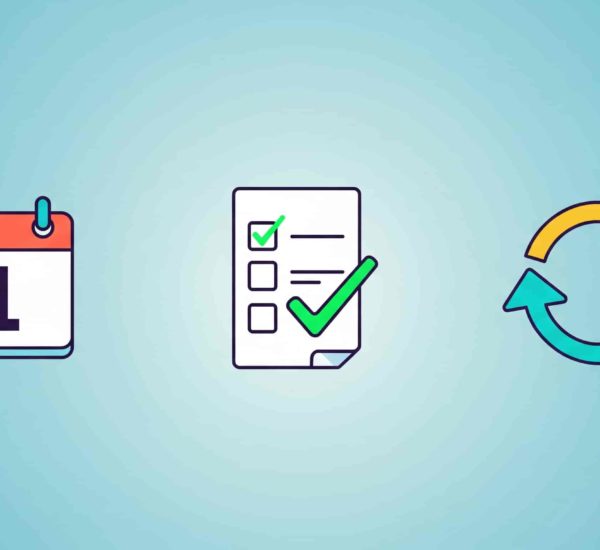In today’s fast-paced work environment, employees face a constant stream of decisions from prioritizing tasks to managing schedules—that can drain their mental energy faster than ever. This phenomenon, known as decision fatigue, quietly chips away at focus, leading to costly mistakes, missed deadlines, and disengagement across teams. For HR leaders supporting multiple departments within mid-sized organizations, this cognitive overload isn’t just a productivity hurdle—it’s a real threat to employee well-being and sustainable performance.
Thankfully, reducing cognitive load isn’t about eliminating all decisions, but about managing them more effectively. By introducing evidence-based techniques and leveraging tools that streamline everyday workflows, HR professionals can help their teams conserve mental energy, sharpen focus, and deliver consistent results without burnout. In this blog, we’ll explore practical strategies grounded in research that empower HR to fight decision fatigue and build a healthier, more efficient workplace culture.
What Is Decision Fatigue and Why It’s a Workplace Productivity Killer
Decision fatigue occurs when the mental energy required to make choices is depleted, leading to poorer decisions or decision avoidance altogether. Think of your brain like a muscle: it can only handle so much cognitive effort before it starts to tire. In a workday filled with constant decision-making—big or small—this depletion can sneak up on employees without them even realizing it.
As cognitive resources drain, people tend to default to easier or habitual choices, sometimes resulting in mistakes, procrastination, or disengagement. For HR leaders, this means the ripple effects of unchecked decision fatigue include decreased productivity, higher error rates, and increased risk of burnout. When employees are overwhelmed by cognitive load, their mental energy isn’t preserved for the tasks that truly matter.
In mid-sized companies juggling multiple teams and projects, the complexity only compounds. Without intentional strategies to manage cognitive overload, employees can become overwhelmed, slowing down workflows and undermining morale. Recognizing and addressing decision fatigue is therefore essential, not just for improving output but for fostering a sustainable work environment where mental energy is protected and optimized.

Signs Your Teams Are Struggling with Cognitive Overload
Decision fatigue and excessive cognitive load rarely announce themselves upfront—they often show up as subtle but damaging patterns in daily work. HR leaders supporting multiple teams should watch for these common signs that mental energy is running low:
- Frequent delays or missed deadlines: When employees hesitate or slow down decision-making, it often signals they’re overwhelmed by too many choices or unclear priorities.
- Increase in errors or quality issues: Mental fatigue reduces focus and accuracy, leading to more mistakes that could have been avoided with clearer workflows or better cognitive load management.
- Procrastination and decision avoidance: Teams may delay important tasks or push decisions aside simply because the mental energy required feels too high.
- Low engagement and motivation: When mental energy is drained, enthusiasm dips, and employees may disengage from their work or team interactions.
- Inconsistent prioritization: Employees struggle to decide what needs immediate attention, leading to reactive work rather than proactive, strategic focus.
These challenges tend to be especially pronounced in mid-sized organizations where employees juggle multiple roles and competing demands. As an HR or People Operations Manager, spotting these symptoms early is key to designing interventions that lighten the cognitive load and preserve mental energy across teams.
Evidence-Based Strategies to Manage Cognitive Load and Preserve Mental Energy
Reducing decision fatigue and managing cognitive load effectively requires intentional, research-backed approaches that help employees make better choices with less mental strain. Here are some practical strategies HR leaders can implement to protect and preserve their teams’ mental energy:
- Prioritize with proven frameworks: Tools like the Eisenhower Matrix help teams categorize tasks by urgency and importance, simplifying daily decisions and focusing mental resources where they matter most.
- Automate routine decisions: Use technology to automate repetitive workflows and send timely reminders, reducing unnecessary cognitive effort. AttendanceBot offers automation and scheduling reminders that minimize daily decision-making.
- Standardize processes: Clear guidelines, templates, and checklists help employees make consistent decisions without overthinking every step. This reduces cognitive load and speeds up execution.
- Encourage regular breaks: Research shows short, frequent breaks restore mental energy and improve focus. Embedding break reminders or “focus time” in calendars can help teams recharge throughout the day.
- Limit multitasking: Promote focused work periods and discourage switching between tasks, which fragments attention and drains mental resources quickly.
By adopting these evidence-based strategies, HR professionals can create workflows and cultural habits that reduce cognitive overload, allowing employees to sustain higher performance and lower burnout risk.
Making the Case to Leadership: Why Reducing Decision Fatigue Matters
For HR professionals championing smarter workflows, securing leadership buy-in is critical to successfully implementing cognitive load management initiatives. Decision fatigue might seem intangible at first glance, but its consequences ripple throughout the organization, affecting productivity, quality, and employee retention in very real ways.
The business impact of decision fatigue is measurable. As employees’ mental energy diminishes, the likelihood of mistakes rises sharply, decisions slow down, and motivation wanes. This leads to missed deadlines, lower-quality work, and a decline in overall team effectiveness. Moreover, chronic cognitive overload contributes significantly to employee burnout—a costly problem that drives turnover, increases absenteeism, and erodes company culture.
Leadership teams need to understand that investing in strategies to reduce decision fatigue is an investment in both employee well-being and the organization’s bottom line. Some compelling outcomes to emphasize include:
- Accelerated decision-making with higher accuracy: By streamlining workflows and reducing unnecessary choices, employees spend less time second-guessing and more time executing. This speeds up project timelines and minimizes costly errors.
- Improved employee engagement and reduced burnout risk: When employees aren’t drained by constant cognitive overload, they remain energized, focused, and motivated to contribute their best work. This directly correlates with lower turnover rates and reduced absenteeism, saving recruitment and training costs.
- Enhanced team morale and collaboration: A workplace culture that values mental energy preservation fosters trust, openness, and resilience. Teams feel supported in managing their workloads effectively, leading to better communication and stronger collaboration.
To translate these benefits into a persuasive business case, HR leaders can:
- Collect data on current challenges: Use pulse surveys, feedback sessions, and performance metrics to document how decision fatigue is impacting employee productivity and engagement. Highlight patterns like frequent task delays, errors, or signs of disengagement linked to cognitive overload.
- Pilot targeted interventions: Implement small-scale tests of cognitive load–reducing strategies, such as automating routine approvals or scheduling reminders via tools like AttendanceBot. Track improvements in workflow efficiency and employee feedback.
- Quantify the ROI: Combine qualitative feedback with quantitative results—such as reduced error rates, faster project completion times, or decreased sick days, to demonstrate how these changes benefit the organization financially and culturally.
- Align initiatives with organizational priorities: Frame cognitive load management as part of broader goals around employee well-being, diversity, equity, and inclusion (DEI), or digital transformation to increase leadership resonance.
By presenting a data-driven, outcomes-focused argument, HR professionals can position cognitive load management not as a “nice to have,” but as a strategic imperative that protects the company’s most valuable resource: its people.

Practical Steps to Start Reducing Decision Fatigue Right Now
Understanding the impact of decision fatigue and cognitive load management is one thing, but turning insight into action is where real change happens. HR leaders ready to lead the charge can start implementing simple but powerful tactics today that ease mental strain and elevate team productivity immediately.
-
Map Out Daily Decision Points
Start by identifying where your teams are making the most frequent or difficult decisions during the workday. Is it managing schedules, approving time off, or prioritizing tasks? Creating a clear map of these decision hotspots helps target solutions where they’ll make the biggest difference. -
Leverage Automation to Eliminate Low-Value Decisions
Tools like AttendanceBot can automate routine choices—such as clock-ins, shift swaps, and reminders—freeing employees from repetitive mental tasks. Setting up these automations only takes minutes but can save hours of cognitive energy weekly. -
Create Decision-Making Playbooks
Develop standardized workflows, checklists, or quick-reference guides for common decisions. When employees don’t have to reinvent the wheel every time, their mental load lightens, allowing them to focus on strategic work. -
Promote Focus Blocks and Breaks
Encourage teams to block off dedicated focus time in their calendars and take short, regular breaks to recharge. Consider integrating tools or calendar apps that send gentle reminders for breaks or “do not disturb” periods to prevent cognitive overload. -
Foster a Culture That Values Mental Energy
Encourage open conversations about cognitive overload and decision fatigue during team meetings or check-ins. Normalizing these challenges empowers employees to ask for support and share strategies that help preserve mental energy.
The Science of Decision Fatigue: How Our Brains Get Overloaded at Work
To effectively combat decision fatigue and optimize cognitive load management, it helps to understand what’s happening inside the brain when mental energy runs low.
Every decision we make consumes a finite resource known as self-control or mental energy. This concept was first popularized by psychologist Roy Baumeister’s research on ego depletion. His studies found that as people make decisions throughout the day, their ability to make thoughtful, high-quality choices diminishes because their mental energy reservoir is drained.
At work, this means that even small, seemingly insignificant decisions—like what to tackle next or how to respond to an email—add up, wearing down employees’ focus and motivation. When cognitive resources are depleted, employees are more likely to:
- Opt for default or habitual choices instead of evaluating options thoroughly
- Experience impaired judgment or snap decisions that lead to errors
- Avoid making decisions altogether, causing delays and bottlenecks
Understanding this brain science empowers HR leaders to design workflows and cultures that replenish mental energy rather than deplete it. For example, scheduling complex decision-making tasks for when employees are mentally freshest (often morning hours), or using tools to automate mundane choices directly supports cognitive restoration.
By sharing this science-backed perspective with leadership and teams, HR can create greater awareness and urgency around reducing decision fatigue, not as a “soft” wellness initiative, but as a critical productivity strategy.
Final Thoughts: Decision Fatigue Is a Business Risk, Not Just a Personal Problem
In today’s fast-paced work environment, decision fatigue and cognitive overload aren’t fringe concerns—they’re core productivity barriers. For HR leaders and People Ops managers, helping teams preserve mental energy isn’t just good for well-being; it’s a strategic move that improves focus, reduces burnout, and leads to smarter, faster decision-making.
By introducing practical changes—like workflow automations, decision playbooks, and time-saving tools such as AttendanceBot—HR professionals can lead the way in building a culture that values mental clarity. These shifts don’t just improve individual performance—they boost organizational resilience and employee retention.
Now’s the time to take action. Start small, share the data, and show leadership how smarter workflows can unlock measurable results.



